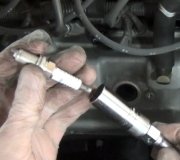The first step is to read and record any diagnostic fault codes. Chrysler made it much easier to do yourself than any other manufacturer. Cycle the ignition switch from "off" to "run" three times in less than five seconds. Keep it in "run", then count the flashes of the Check Engine light. You'll get two sets of flashes with a slightly longer pause in between the two digits. Once you get any codes, this page lists the definitions, or I can look them up for you.:
https://www.2carpros.com/articles/retrieve-trouble-codes-for-chrysler-dodge-plymouth-odb1-1995-and-earlier-car-mini-van-and-light-trucks
Unfortunately, '95 and older models have emissions systems with diagnostic fault codes that are quite limited in the information they provide. Still, they will lead you to the right circuit or system to start the diagnosis.
There is a very elusive fuel supply system problem that can cause what you described, but by far the more common cause is a failing crankshaft position sensor or camshaft position sensor. For '94 models, signals must arrive from both sensors for the engine to run.
If we're lucky, there will be a fault code indicating which sensor circuit is being lost, but if there is no code set, that doesn't mean we can assume both of them are okay. The Engine Computer needs a little time to detect the missing signal, such as when a stalling engine is coasting to a stop. Usually just cranking the engine isn't sufficient to set a code.
You can read fault codes with a scanner or with a very inexpensive code reader, but again, if there is no related code set, there's two ways to continue the diagnosis. One is with the scanner viewing live data. Both sensors will be listed with a "No" or "Present" to denote whether their signals are showing up during cranking. You're looking for one that stays on "No". It's important to understand that these fault codes never ever say to replace a part or that one is defective. Judging by the way the failure occurs so regularly, it's a good bet this IS caused by a sensor as they both commonly fail on all car brands by becoming heat-sensitive, then they work again after cooling down for about an hour.
When you don't have access to a scanner, you can at least verify one of those sensors is suspect with a test light. You'll find a wire that is the same color at each of the six injectors and at the ignition coil pack. As I recall, that will be dark green with an orange stripe, or "tracer". Use that wire at any of those plugs, or you can even use either smaller terminal on the back of the alternator. You can use a digital voltmeter too, but most don't respond fast enough. That's why I prefer the test light. Harbor Freight Tools has either one for less than ten bucks. If you need help using a test light, refer to this article:
https://www.2carpros.com/articles/how-to-use-a-test-light-circuit-tester
For this task, the test light should be of the inexpensive type with a simple light bulb, not one of the fancy new ones with a built-in voltmeter. We aren't interested in the exact voltage. We just want to see if you have something or nothing.
Back-probe through an injector connector next to the dark green / orange wire in a way that you can see the light from inside the van, or have a helper run the ignition switch for you. If you start this test with a cold engine, proper operation is for the test light to light up for one second when you turn the ignition switch to "run", then it will turn back off. What is important is it must light up again as soon as you start cranking the engine. When the two sensors are still cold and the engine remains running, the test light will be lit up.
Now that you see what "normal" looks like, do that again right after the engine has stalled. My suspicion is it will still light up for one second, but not when you start cranking the engine. That points to one of those two sensor circuits.
If that's what you find, standard practice for a professional is to check the three voltages at each sensor to rule out wiring and connector terminal problems before blindly replacing the sensor. We don't like randomly throwing parts at a problem. As I mentioned earlier, these sensors do commonly fail in the way you described, but we like to be sure before we spend our customer's money on a part.
In this application, the sensors have critical air gaps that are set with a thick paper spacer glued to the end of them. That spacer is done doing its thing as soon as the sensor is installed, then they get tugged off and discarded as soon as the engine rotates from cranking or running. If you install a used sensor, you need to purchase another one of those spacers. The dealer may give you one. Auto parts stores often sell them only in a set of ten.
Some aftermarket sensors use a thin plastic rib molded onto the end of the sensor to set that air gap. Those ribs get chewed off over time. When installing a used one of that design, you're supposed to cut the remaining part of the rib off, then use a paper spacer.
Many years ago, at the dealership, I was too arrogant to always use that spacer. Instead, I thought I could just stuff the sensor in as far as it would go, then pull it back out just a little. That did work for a while, but the last one came back two weeks later with the same intermittent stalling problem you're having. I don't know why it took so long to act up, but it was my fault for not using that spacer.
Let me know how far you get with these tests.
Thursday, June 6th, 2024 AT 7:40 PM



